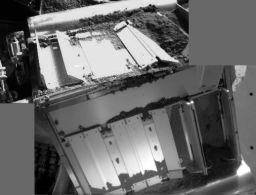Emily Lakdawalla • Dec 11, 2008
Some interesting information in a Nature story about Phoenix
EDIT: Nature has issued a correction to this story.
I just came across a long article in Nature on Phoenix, by journalist and sometimes blogger Eric Hand, that contained two tidbits of information about the mission that I had not previously been aware of.

NASA / JPL / UA / MPI / collage by Emily Lakdawalla
The TEGA instrument as of sol 96
This mosaic shows the TEGA instrument on Phoenix as of sol 96. The upper half of the instrument (as seen in this mosaic) includes, from left to right, ovens 7, 6, 5, and 4 (the last one is only partially visible). Only oven 6 was still closed at the time the photo was taken. The bottom half of the instrument includes, from left to right, ovens 3, 2, 1, and 0; ovens 3 and 2 remained unopened, and oven 0 is the only one whose doors opened properly. Ovens 1, 4, and 7 had one door open partially and one fully. Oven 5 had both doors open partially.One of the differences between the TEGA on Phoenix and that on [Mars Polar Lander] was a thin retracting cover to keep the instruments from being contaminated by any stowaway microbes from Earth. [TEGA instrument head Bill] Boynton and his team had noticed, on a test version of TEGA, that the brackets at the bottom of this cover were just a hair's width too big, and as a result obstructed the doors. They sent revised designs for the cover to the manufacturer, Honeybee Robotics of New York. New parts were delivered and installed. But Honeybee had made the new parts using the original flawed designs -- and nobody in Tucson checked them. "They should've caught it and we should've caught it, but neither of us did," says Boynton, ruefully.
Ouch ouch ouch. That's a painful revelation.
The other interesting tidbit of information was that, about a month into the mission, NASA headquarters stepped in to issue orders to the operations team on how to use TEGA. NASA was nervous about all the problems that had cropped up, so, Eric wrote, "At the end of June, word came down that the Phoenix team was to treat its next TEGA sample as its last, and to go after a sample of rock-hard ice before it did anything else. The Tucson team had lost its autonomy." If you read this blog throughout the Phoenix mission you'll recall what followed; it's all detailed in my sol-by-sol summary of the mission. They expended more than a month of precious highest-power mission time to try to get an ice sample into the instrument, an effort that caused the team to put off doing other types of analyses, and which ultimately failed.
Ouch again.
Strong reporting by Eric Hand; read his full article here.
Support our core enterprises
Your support powers our mission to explore worlds, find life, and defend Earth. You make all the difference when you make a gift. Give today!
Donate

 Explore Worlds
Explore Worlds Find Life
Find Life Defend Earth
Defend Earth

